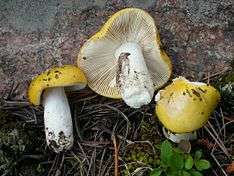Russula claroflava
Russula claroflava, commonly known as the yellow swamp russula or yellow swamp brittlegill, is a basidiomycete mushroom of the genus Russula. It is found in wet places under birch and aspen woodlands across Europe and North America. It has a yellow cap, white gills and stipe and bruises grey. It is mild-tasting and regarded as good to eat.
| Russula claroflava | |
|---|---|
 | |
| Scientific classification | |
| Kingdom: | |
| Division: | |
| Class: | |
| Order: | |
| Family: | |
| Genus: | |
| Species: | R. claroflava |
| Binomial name | |
| Russula claroflava Grove (1888) | |
| Russula claroflava | |
|---|---|
float | |
| gills on hymenium | |
| cap is convex | |
| hymenium is free | |
| stipe is bare | |
| spore print is white | |
| ecology is mycorrhizal | |
| edibility: choice | |
Taxonomy
It was described in 1888 by William Bywater Grove, based on a specimen from Sutton Park in the English Midlands.[1] Its specific epithet is derived from the Latin clarus 'bright' or 'clear', and flava 'light yellow'.[2]
Description
This medium-sized member of the genus Russula has a cap that is an egg-yolk yellow. Measuring 4–10 cm (1.5 4 in) in diameter, it is slightly sticky when moist,[3] and leaves and other debris often stick to it. There is usually a slight depression in the centre of mature specimens, with the margin becoming furrowed. The cap is half peeling. The 4–10 cm (1.5–4 in) high stem is white, fairly firm, straight and 1–2 cm thick. Its gills are pale ochre, and are adnexed to almost free. All parts turn dark grey on aging or bruising.[3] The smell is fruity and the spore print is pale ochre, and the oval warty spores average 9.5 x 8 μm.[4] The edible but acrid Russula ochroleuca resembles this species, but has a duller yellow cap.[5]
Distribution and habitat
Russula claroflava appears in summer and autumn, usually with birch (Betula), or aspen (Populus), on heaths and moors, preferring damp places near ponds or lakes, often occurring in sphagnum. It is occasionally found in drier places. It occurs in Britain,[4] across northern Europe, and throughout North America.
Edibility
This mushroom is edible and good, with a mild taste, both in Europe and North America.[4][5]
See also
References
- Grove WB. (1888). "Wayside notes". Midland Naturalist. 11: 265–266.
- Nilson S, Persson O (1977). Fungi of Northern Europe 2: Gill-Fungi. Penguin. p. 114. ISBN 0-14-063006-6.
- Holmberg, Pelle. (2013). The pocket guide to wild mushrooms : helpful tips for mushrooming in the field. Marklund, Hans, 1937-, Hedström, Ellen. New York: Skyhorse. ISBN 9781620877319. OCLC 816030405.
- Phillips R (2006). Mushrooms. London: Pan MacMillan. p. 40. ISBN 0-330-44237-6.
- Arora, David (1986). Mushrooms demystified: a comprehensive guide to the fleshy fungi (2nd ed.). Berkeley: Ten Speed Press. p. 92. ISBN 0-89815-169-4.
Cited literature
- Marcel Bon, The Mushrooms and Toadstools of Britain and North Western Europe.
- Courtecuisse and Duhem, Mushrooms and Toadstools of Britain and Europe.